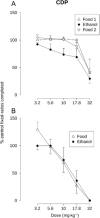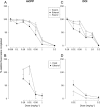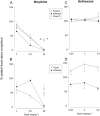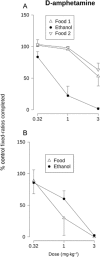Drug effects on multiple and concurrent schedules of ethanol- and food-maintained behaviour: context-dependent selectivity
- PMID: 24697498
- PMCID: PMC4105936
- DOI: 10.1111/bph.12707
Drug effects on multiple and concurrent schedules of ethanol- and food-maintained behaviour: context-dependent selectivity
Abstract
Background and purpose: Drugs that more potently or effectively reduce ethanol-maintained behaviour versus an alternative are considered selective and are considered promising pharmacotherapies for alcoholism. Such results are often obtained using separate groups or multiple schedules where ethanol and the alternative are available alone or sequentially. Recently, we observed that when ethanol and food were available sequentially under a multiple schedule, fluvoxamine and varenicline were selective; yet this selectivity disappeared when ethanol and food were concurrently available.
Experimental approach: We examined the generality of these findings by comparing doses of several drugs required to decrease ethanol- and food-maintained responding under a multiple schedule and under a concurrent schedule. Effects were determined for chlordiazepoxide, 2,5-dimethoxy-4-iodoamphetamine (DOI), meta-chlorophenylpiperazine (mCPP), morphine, naltrexone and d-amphetamine.
Key results: Under the multiple schedule, ED50 values for decreases in ethanol-maintained responding were significantly different and lower than ED50 s for decreases in food-maintained responding (demonstrating selectivity) for each drug except for chlordiazepoxide (which was equipotent) and naltrexone (which did not affect responding). However, this selectivity vanished or even inverted under the concurrent schedule, such that ED50 values for decreasing ethanol- and food-maintained responding were not different (or, following DOI, the ED50 for food-maintained responding was lower than for ethanol-maintained responding).
Conclusions and implications: Results are consistent with those seen following fluvoxamine and varenicline administration, and suggest that selectivity is assay-dependent. These results indicate the need for careful interpretation of selective drug effects, especially when obtained in situations where ethanol or the alternative is the only programmed reinforcement available.
Keywords: 5-HT; alcohol; benzodiazepine; choice; operant; opioid; pharmacotherapy; rat.
© 2014 The British Pharmacological Society.
Figures




Similar articles
-
Relative potency of varenicline or fluvoxamine to reduce responding for ethanol versus food depends on the presence or absence of concurrently earned food.Alcohol Clin Exp Res. 2014 Mar;38(3):860-70. doi: 10.1111/acer.12285. Alcohol Clin Exp Res. 2014. PMID: 25396255 Free PMC article.
-
Comparison of dehydroepiandrosterone (DHEA) and pregnanolone with existing pharmacotherapies for alcohol abuse on ethanol- and food-maintained responding in male rats.Alcohol. 2015 Mar;49(2):127-38. doi: 10.1016/j.alcohol.2014.07.024. Epub 2015 Jan 6. Alcohol. 2015. PMID: 25620274 Free PMC article.
-
Effects of varenicline on ethanol- and food-maintained responding in a concurrent access procedure.Alcohol Clin Exp Res. 2013 Jul;37(7):1228-33. doi: 10.1111/acer.12085. Epub 2013 Feb 15. Alcohol Clin Exp Res. 2013. PMID: 23413834 Free PMC article.
-
The potency of fluvoxamine to reduce ethanol self-administration decreases with concurrent availability of food.Behav Pharmacol. 2012 Apr;23(2):134-42. doi: 10.1097/FBP.0b013e32834f9f9d. Behav Pharmacol. 2012. PMID: 22205211 Free PMC article.
-
Effects of fluvoxamine on a multiple schedule of ethanol- and food-maintained behavior in two rat strains.Psychopharmacology (Berl). 2005 Jul;180(2):249-57. doi: 10.1007/s00213-005-2156-z. Epub 2005 Jan 29. Psychopharmacology (Berl). 2005. PMID: 15682293
Cited by
-
Development of a novel alcohol and nicotine concurrent access (ANCA) self-administration procedure in baboons.Drug Alcohol Depend. 2020 Jan 1;206:107665. doi: 10.1016/j.drugalcdep.2019.107665. Epub 2019 Nov 11. Drug Alcohol Depend. 2020. PMID: 31801108 Free PMC article.
-
Varenicline and GZ-793A differentially decrease methamphetamine self-administration under a multiple schedule of reinforcement in rats.Behav Pharmacol. 2018 Feb;29(1):87-97. doi: 10.1097/FBP.0000000000000340. Behav Pharmacol. 2018. PMID: 28863003 Free PMC article.
-
Equal response rates maintained by concurrent drug and nondrug reinforcers: a design for treatment evaluation.Behav Pharmacol. 2020 Aug;31(5):458-464. doi: 10.1097/FBP.0000000000000525. Behav Pharmacol. 2020. PMID: 31770113 Free PMC article.
-
Determinants of choice, and vulnerability and recovery in addiction.Behav Processes. 2016 Jun;127:35-42. doi: 10.1016/j.beproc.2016.04.001. Epub 2016 Apr 12. Behav Processes. 2016. PMID: 27083500 Free PMC article. Review.
References
-
- Bell RL, Kimpel MW, Rodd ZA, Strother WN, Bai F, Peper CL, et al. Protein expression changes in the nucleus accumbens and amygdala of inbred alcohol-preferring rats given either continuous or scheduled access to ethanol. Alcohol. 2006;40:3–17. - PubMed
-
- Bell RL, Rodd ZA, Engleman EA, Toalston JE, McBride WJ. Scheduled access alcohol drinking by alcohol-preferring (P) and high-alcohol-drinking (HAD) rats: modeling adolescent and adult binge-like drinking. Alcohol. 2013 doi: 10.1016/j.alcohol.2013.10.004. - DOI - PMC - PubMed
-
- Benjamini Y, Hochberg Y. Controlling the false discovery rate: a practical and powerful approach to multiple testing. J Roy Statist Soc Ser B Methodol. 1995;57:289–300.
Publication types
MeSH terms
Substances
Grants and funding
LinkOut - more resources
Full Text Sources
Other Literature Sources
Medical

